
|
|
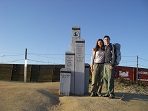 |
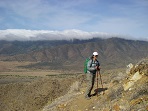 |
 |
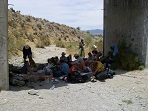 |
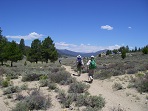 |
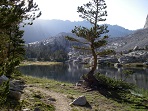 |
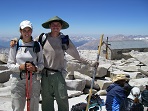 |
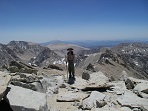 |
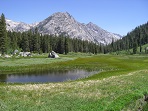 |
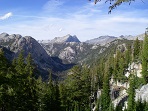 |
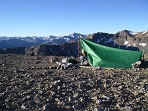 |
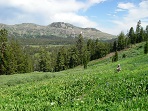 |
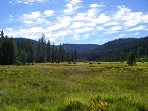 |
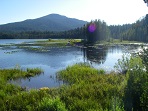 |
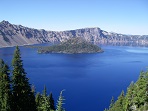 |
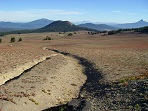 |
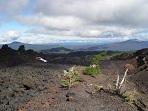 |
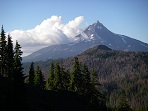 |
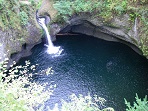 |
 |
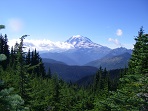 |
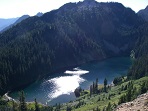 |
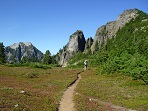 |
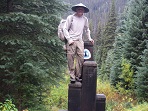 |
2007 Pacific Crest Trail Thru-Hike
What is it:
The Pacific Crest Trail spans roughly 2,663 miles from the Mexican boarder, through California, Oregon, and Washington to Canada.
When:
On the PCT you don't want to start too early, or you will reach the High Sierra mountains before the snow has melted suffiently enough to pass through. You have to move relatively quickly because the snow storms can start in northern Washington in mid to late September. Most people are able to do the PCT in about five months.
My wife Sheryl and I started at the Mexican border on April 29th right after the PCT Kick off party. Sheryl broke her foot and had to get off about half way. I finished alone in Canada on September 22nd 2007.
What is it like:
The first 700 miles or so of the PCT travel through high desert in southern California. Water is scarce in the desert, but there are numerous man-made water sources such as faucets at campgrounds, or water caches (jugs of water) left by trail angels at road crossings. You occasionally are required to go 20-30 miles between water sources requiring you to carry up to 5-6 liters (13 lbs) of water. Most of the long carries can be done in a day.
It doesn't rain much in the desert and there aren't many insects. Most nights you can curl up under a tree or sleep under the stars. We probably only pitched our tent one in five nights on the PCT as a whole, only in buggy sections or if the weather looked ominous.
After 700 miles or so the PCT exits the desert and ascends into the High Sierras, one of the most remote and highest elevation areas in the US. There will likely be snow fields left from the previous winter. Icy passes, swollen river crossings, lightning storms, and hordes of mosquitoes can all be hazards in the Sierras.
In Oregon you will see dormant volcanoes, cross lava fields, pass by hundreds of pristine lakes, and millions of pine trees. I went for a swim almost every day in Oregon.
The mountains in Washington are nearly as spectacular as the high Sierras, but don't delay or the weather turns rainy, or worse you could get snowed out and be forced to end your hike early.
Logistically
the PCT is not that bad. The trail may not always be marked, but it is well worn and easy to follow. You will only occasionally need to check your maps or compass to stay on track. There are some relatively long sections between resupply, and managing water can be an issue.Trail towns and resupply are generally about 4-6 days apart. The longest section is around 180 miles through the High Sierra mountains. It took us 11 days, including a summit of the lower US's highest peak, Mount Whitney. There are a couple places where you can hike out of the High Sierras to break it up with a resupply, but that requires extra days and miles on side trails.
The PCT has some sections that are pretty remote, and help is not always easy to come by. There are only a couple shelters on the PCT so you must rely on your own tent or tarp.
Physically
the PCT is a joy to hike. The entire PCT is designed to allow pack animals like horses or mules to traverse it. What this means is it is well graded with few very steep sections and no rocky scrambles. You will ascend and descend very gradually for miles at a time rather than going straight up and over anything. The PCT normally contours around mountains and rarely goes over summits except on optional side trails. It is not uncommon to walk 25 to 30 miles in a day once you get into the swing of things.The PCT is very well maintained due to many volunteers. There are few roots or rocks, and since it is so dry it doesn't get overgrown very quickly.
Most of the PCT is open and exposed. This means you get great views all the time, but you are also in the sun all day long. Long sleeves, pants, and a sun hat are a good idea.
Weather:
Temperatures in the desert can get up to the 90's Fahrenheit in the day, and can drop below freezing at night. Much of the time you are up high in the mountains, so the temperature isn't always unbearable. Many hikers try to walk early in the morning or late at night, and take a siesta under a bush or behind a rock during the hottest part of the day. Some sections have very few trees.
The nights are almost always chilly, or outright cold. It is possible to get a freak snow storm even in the desert. Don't underestimate how cold it can be in the desert.
You may also encounter snow in the High Sierras if you are early, and again in Washington state if you don't finish soon enough.
Rain is scarce on the PCT. If you are lucky it might only rain 5-10 times on the whole five month trip, but you still need to be prepared for storms.
The PCT can be extremely windy, especially in the desert or when camped up high. Be prepared to camp in wind that gusts all night.
Updated Pacific Crest Trail Gear List:
On the PCT you need to be prepared for temperatures from below freezing to hot and exposed. It doesn't rain very often but you need at least minimal rain gear and shelter. It can be very windy. There are a few sections where you may need to carry 20-25 lbs of food and water in addition to your gear. If your base gear weight is under 10lbs you can do the PCT w/o going over 30-35 lbs total.
This is the gear list that I would take if I were to do any three-season thru-hike today.
| Ounces | Packing System |
| 21 | Arc Blast Backpack |
| 1 | Pair Shoulder Pouches |
| 1.5 | Pair Belt Pouches |
| Ounces | Shelter System |
| 14.8 | Plexamid Tent |
| 2.1 | 8x Carbon Tent Stakes w/ stake sack |
| Ounces | Sleeping System |
| 18.7 | Zpacks 20F Slim, Long Classic Sleeping Bag |
| 1.7 | Medium Pillow Dry Bag |
| 8 | Neoair Xlite Pad, size small |
| Ounces | Cooking System |
| 3.3 | .6L Evernew Pot |
| .2 | Titanium short handle spoon |
| .5 | Lightload Towel |
| .4 | Mini-Bic Lighter |
| 2.3 | Soto Windmaster Stove |
| 1.4 | Roll top Food Bag |
| Ounces | Water Storage |
| 1.5 | 1 Quart Powerade Bottle |
| 1.5 | 1 Quart Powerade Bottle |
| 0 | No water treatment. |
| Ounces | Miscellaneous Items |
| 6 | Galaxy S9 Smartphone / Camera |
| 6 | Anchor 10,000 mAh PowerCore battery |
| 1.5 | Pak-Light w/ homemade headband |
| .7 | Victorinox Classic Pocket Knife |
| .5 | Silva Compass / Thermometer |
| .7 | Zpacks Travel Toothbrush |
| 1 | Passport, Credit Card, License, Cash in Travel Zip |
| 1.7 | 50ft 2 mm Z-Line cord |
| .4 | 4x Mini-D Carabiners |
| .3 | Chap Stick |
| .01 | Ear plugs |
| .8 | Sunglasses |
| .1 | Ibuprofen |
| Ounces | Gear Repair |
| .6 | 3x strips of DCF Repair Tape |
| .1 | 6x Large safety pins |
| .35 | Sewing repair kit |
| Ounces | Carried Clothing |
| 6.2 | Vertice Rain Jacket |
| 3.6 | Vertice Rain Pants (Optionally substitute Rain Kilt in warmer weather). |
| 1.0 | Vertice Rain Mitts |
| .9 | Zpacks Fleece Hat |
| 2 | Zpacks Wind Shell Jacket |
| 8.9 | Zpacks Climashield insulated Jacket |
| 1 | Medium-Plus Dry Bag |
| Ounces | Optional clothing to add for colder weather |
| 1.4 | Possum Down Gloves |
| 2.5 | Possum Down Socks |
| Ounces | Worn Items (Not part of base weight) |
| 10.2 | Columbia Silver Ridge II Zip off pants |
| 7.3 | Long sleeve, breathable shirt w/ hood |
| .9 | Ultamax Triathlete low cut socks |
| 3.5 | Patagonia boxers |
| 2.4 | Zpacks Trucker Hat |
| 23 | Teva Grecko Sandals (discontinued model) |
| 7.3 | Zpacks Carbon Fiber Staff |
| Ounces | Total Base Weight |
| 124 | 7 lbs 12 ounces (3.5 kg) |

